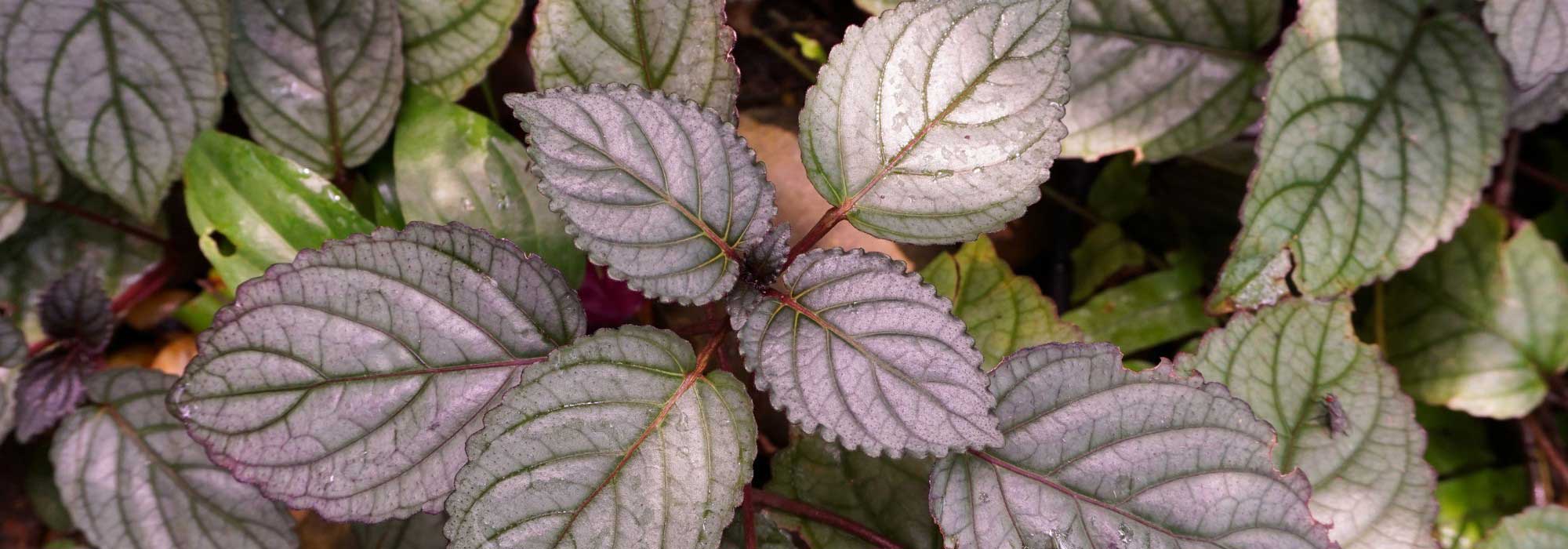
Hemigraphis: growing and care
Contents
Hemigraphis in a nutshell
- Hemigraphis is a highly ornamental house plant, native to Southeast Asia.
- It is primarily grown for its foliage in shades of purple, silver, or metallic.
- Its spreading, trailing habit makes it ideal for hanging.
- Its crinkled, colourful leaves add contrast to plant displays.
- Easy to care for, it requires little maintenance, provided it is kept warm and out of direct sunlight.
A word from our expert
Hemigraphis is an ornamental plant that is still relatively unknown, yet it deserves to be more widely cultivated. Native to the tropical regions of Southeast Asia, this plant captivates with its colourful foliage featuring metallic reflections, often in shades of purple, mauve, or silver. Grown in pots indoors, Hemigraphis adds a lovely touch of exoticism and modernity.
Often cultivated for its decorative foliage rather than its flowering, Hemigraphis is valued for both its aesthetics and ease of care. It is also used in plant displays or as a trailing plant in hanging arrangements, adding texture and colour to green decor.
In this article, we will explore the various facets of this fascinating plant: its botanical characteristics, the available varieties, best practices for planting and care, as well as propagation methods and possible associations to enhance its appeal. If you are looking for an original and easy-going plant, Hemigraphis could well become your new favourite!
Description and botany
Botanical data
- Latin name Hemigraphis alternata
- Family Acanthaceae
- Common name Metallic plant, Hemigraphis
- Flowering Summer; small tubular flowers, white to mauve, not very spectacular
- Height 20 to 30 cm
- Exposure Filtered light to partial shade, no direct sunlight
- Soil type Light, rich, cool and well-drained
- Hardiness Tender (minimum temperature of 10 to 12 °C)
Hemigraphis is a plant native to the warm and humid regions of Southeast Asia, particularly Indonesia, Malaysia, India, and the Philippines. In its natural habitat, it often grows in understorey areas, sheltered from direct light, in rich, moist soil.
Hemigraphis belongs to the Acanthaceae family, a large family of tropical plants that includes many ornamental species. It is also commonly known as the “metallic plant” or “iron leaf plant,” referring to the lustrous appearance of its foliage. In English, it is commonly called “Purple waffle plant” due to its crinkled leaves, or “Red flame ivy plant”.
Hemigraphis is a non-hardy plant: it does not tolerate temperatures below 10 °C. In temperate climates, it is therefore grown indoors or in greenhouses, while it can be planted outdoors in tropical or subtropical regions.
It is an herbaceous plant with a spreading or trailing habit, depending on the variety. It quickly forms a dense carpet of foliage, making it ideal as groundcover or for edging planters. Generally, it does not exceed 20 to 30 cm in height, but can spread widely laterally.
The main attraction of Hemigraphis lies in its leaves. They are often ovate to lanceolate, with undulating or crenate edges, and display colours ranging from dark green to intense purple, sometimes with silver or metallic highlights. The undersides of the leaves are often more colourful, dark red or purple, providing a lovely contrast.
The flowering, although discreet, is not without charm. The small flowers, often white, pale mauve, or blue, appear in summer. They last only a short time and are rarely the main decorative element of the plant. It is truly its foliage that takes precedence.
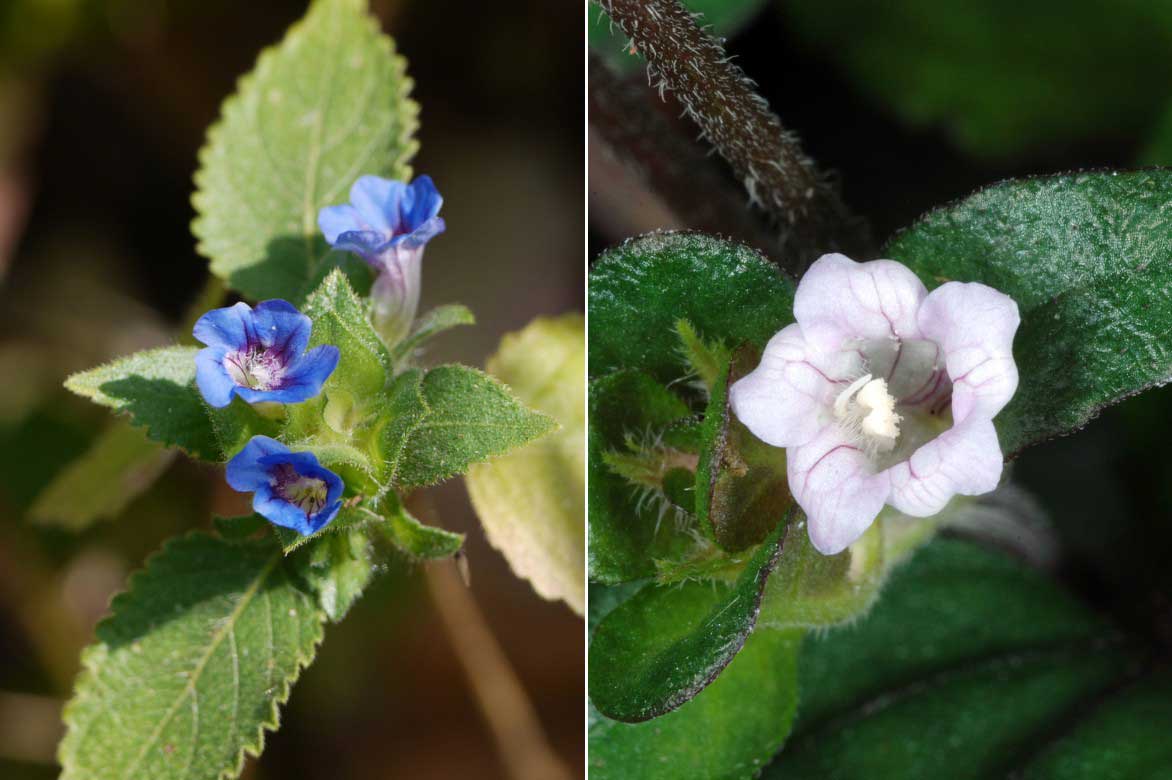
The flowering of Hemigraphis latebrosa (photo: Dinesh Valke) and that of Hemigraphis reptans (photo: Douglas Goldman)
The genus Hemigraphis comprises about 30 to 40 species, but only a few are commonly cultivated. Here are the most popular ones and their distinctive characteristics:
- Hemigraphis alternata : This is the most widespread species and the one most often found in ornamental cultivation. Its foliage is metallic purple on top, with marked veins and a purple underside. It is perfect as groundcover or in hanging pots. It is also found under the name Hemigraphis colorata. Among the most beautiful varieties, ‘Exotica’ is highly valued for its dark green to purplish, shiny, and heavily crinkled leaves, with a purple-pink underside.
- Hemigraphis repanda : This species is recognised by its narrow leaves and irregular edges. Less common in cultivation, it nonetheless offers an original texture in a plant composition.
- Hemigraphis latebrosa : Less known, this species has a creeping habit and bronze-green foliage. It is sometimes used as a ground cover plant in tropical gardens.
Each of these species can find its place depending on the desired use: vegetative carpet, decorative pot, trailing plant… The choice will also depend on the growing conditions available to you.
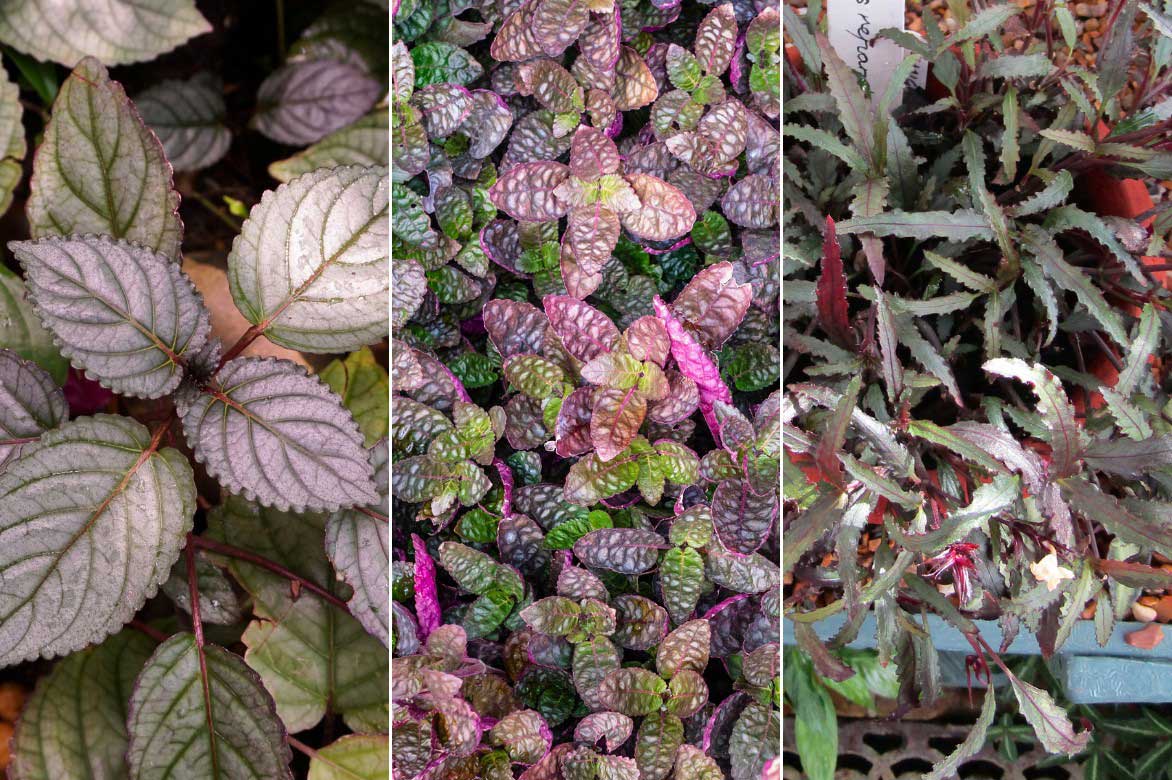
Hemigraphis alternata (type species), Hemigraphis alternata ‘Exotica’ and Hemigraphis repanda (photo: Leonora Enking)
“`
The main species and varieties
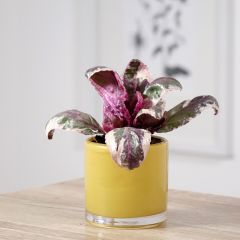
Hemigraphis alternata Snow White - Purple Waffle plant
- Flowering time July to October
- Height at maturity 15 cm
Planting Hemigraphis
Where to place Hemigraphis?
Hemigraphis thrives in bright, indirect light. It should ideally be positioned near a window facing east or west, but never in direct sunlight, which could scorch its delicate leaves. A bright room, such as a well-lit living room or bathroom, is perfect for it. In too dark an area, its colours fade and its growth slows down.
When to plant it?
Indoors, Hemigraphis can be planted at any time of the year, but the best time to plant or repot it is in spring. During this season, the plant enters a period of active growth, which encourages good establishment and rapid leaf development.
How to plant it?
Here are the steps to successfully plant Hemigraphis in a pot:
- Choose a pot with drainage holes at the bottom to ensure good drainage and prevent excess moisture.
- Add a layer of clay balls or gravel at the bottom of the pot to promote water drainage.
- Fill the pot with a light, rich, and well-draining substrate, ideally a potting mix for green plants mixed with a bit of perlite, sand, or coconut fibre.
- Gently remove the plant from its original pot, loosening the roots if they are very compacted.
- Place the root ball in the centre of the new pot, then fill in with substrate around it, pressing down lightly.
- Water thoroughly to moisten the entire soil and ensure good contact between the substrate and the roots, avoiding air pockets.
Once planted, place Hemigraphis in a bright spot but protected from direct sunlight. It should quickly resume growth and thicken its colourful foliage.
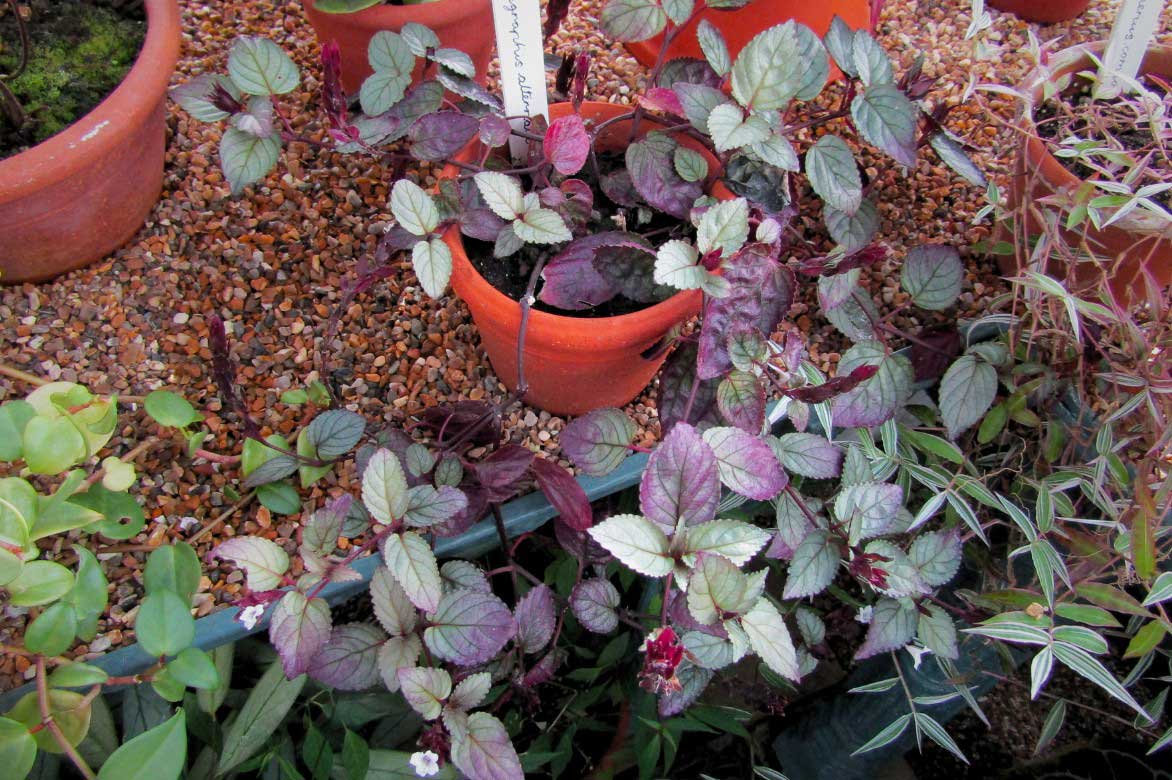
Hemigraphis alternata (photo: Leonora Enking)
How to care for Hemigraphis?
Caring for Hemigraphis is relatively simple, making it an excellent plant for beginners. However, a few regular actions are necessary to maintain its vibrant foliage and healthy growth.
Watering
Hemigraphis enjoys humidity, but not excessive amounts. The substrate should remain slightly moist, especially during the growth period (spring and summer). Do not allow water to stagnate in the saucer. In winter, reduce watering, allowing the substrate to dry slightly between waterings.
Be cautious of stagnant water: excess moisture can lead to root rot. Always ensure good drainage.
As a tropical plant, Hemigraphis loves a humid atmosphere. If the air is too dry, especially indoors in winter, regularly mist the leaves with non-calcareous water. You can also place the pot on a bed of moist clay pebbles.
Temperature
Hemigraphis prefers temperatures between 18 and 25 °C. Below 15 °C, its growth slows, and damage may occur. Never expose it to frost.
Pruning and cleaning
Pinch the tips of the stems regularly to encourage branching and achieve a denser plant. Remove damaged or yellowing leaves as soon as you see them.
Fertilisation
You can apply a liquid fertiliser for green plants every 15 days in spring and summer. Space out applications in autumn and stop them in winter.
Diseases and pests
Hemigraphis is generally a robust plant when grown under suitable conditions, but like any houseplant or tropical climate species, it can encounter some health issues, particularly if the environment is not suitable.
One of the main afflictions of Hemigraphis is root rot. This occurs mainly when the plant is overwatered or the substrate does not drain sufficiently. In this case, the roots, constantly saturated with water, begin to decompose, leading to a general wilting of the plant, yellowing or drooping foliage, and an unpleasant smell from the potting mix. To avoid this problem, it is essential to ensure good drainage of the pot, not to let water stagnate in the saucer, and to adjust watering according to the season.
Moreover, an environment that is too dry or poorly ventilated can encourage the appearance of pests. Hemigraphis is sometimes susceptible to attacks from red spider mites, especially during winter when indoor air becomes too dry due to heating. These microscopic mites weave fine webs and cause discoloration of the foliage, with yellowish or silvery patches. In this case, increasing the ambient humidity by regularly misting the plant may be enough to halt a light infestation. A solution based on black soap can also be used if the invasion becomes more significant.
Hemigraphis can also be attacked by mealybugs. They can be identified by the presence of small white cottony masses on the stems. If you see them, you can remove them using a cloth or a cotton swab soaked in 90° alcohol or soapy water.
Whiteflies, also known as white flies, can also appear on Hemigraphis, particularly in warm and poorly ventilated environments. These small white insects fly off as soon as the plant is moved, and their larvae weaken the plant by sucking the sap. Again, good ventilation, regular rinsing of the foliage, or the use of a natural treatment like neem oil can be effective.
Finally, although this is rarer, aphids can also settle on young shoots, particularly in spring. They feed on the sap and can slow the plant’s growth or even cause deformities. Their presence is often revealed by a sticky honeydew on the leaves. A wash with soapy water or a biological treatment can easily resolve this issue.
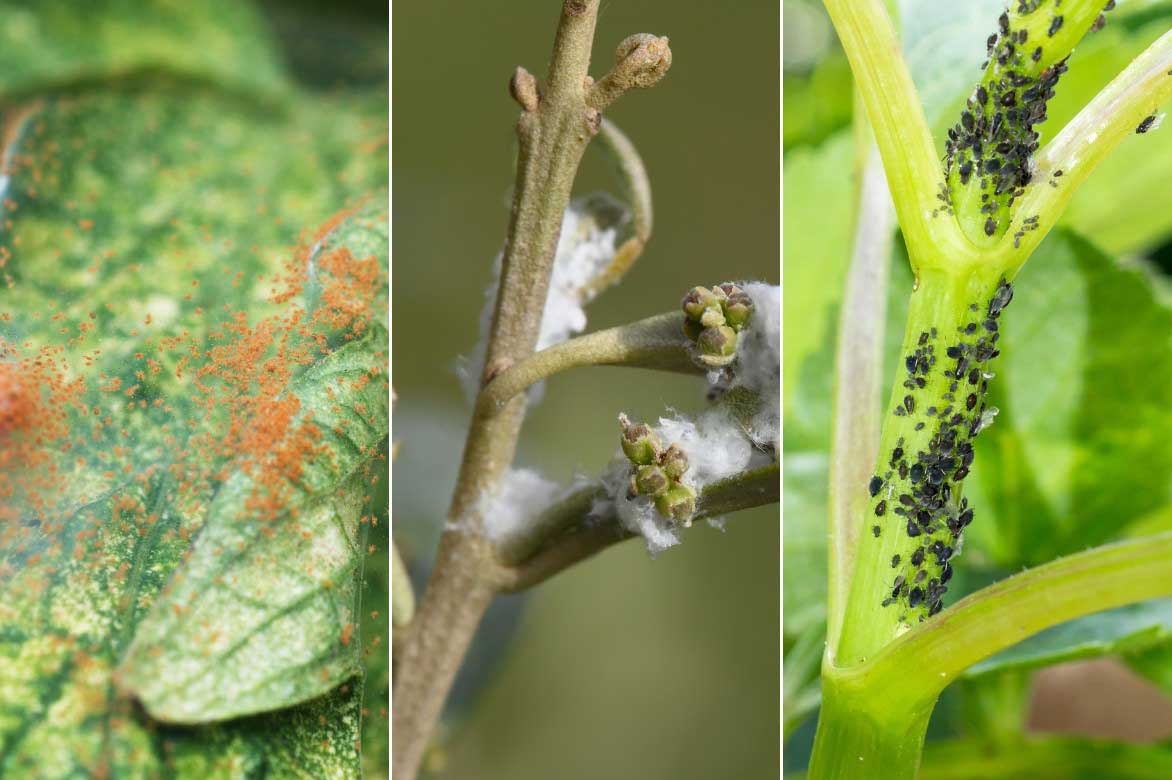
Red spider mites, mealybugs, and aphids
How to propagate Hemigraphis?
How to propagate Hemigraphis by cuttings?
Propagation by cuttings is the quickest and most commonly used method to multiply Hemigraphis, especially indoors.
When to propagate Hemigraphis?
Propagation is ideally done in spring or summer, during the active growth period. Mild temperatures and ambient humidity promote rapid root development. Outside this period, recovery may be slower or even compromised if the temperature is too low.
How to do it?
Here are the steps to successfully propagate your cuttings:
- Take a healthy stem 10 to 15 cm long, choosing a segment with several nodes (the points where leaves attach to the stem). Cut the cutting just below a node.
- Remove the leaves from the lower part of the stem to expose the areas where roots will develop.
- Place the cutting:
- either in a glass of water, submerging the lower nodes (change the water every two to three days);
- or directly in a small pot filled with light, moist potting soil.
- Keep the cutting in indirect light at a temperature of 20-25 °C.
- Transplant the cutting once the roots are 3 to 5 cm long, into a larger pot.
How to layer Hemigraphis?
Layering is a gentler and more natural method, ideal if you want to multiply an already well-developed plant without disturbing it.
When to layer Hemigraphis?
As with propagation by cuttings, layering yields better results in spring or summer when the plant is actively growing. However, indoors, this method can also be practiced in autumn if conditions are suitable (sufficient warmth and light).
How to do it?
To successfully layer your plant, follow these steps:
- Prepare a pot by filling it with light, well-draining substrate.
- Choose a long, flexible stem that can easily be bent to the substrate of the new pot.
- Identify a node (the point where a leaf emerges) on the stem.
- Bury the part of the stem where the node is, keeping it in contact with the soil using a wire hook or a small stone.
- Water regularly to keep the substrate moist, but not soggy.
- Wait a few weeks for roots to form at the node.
- Detach the new plant from the mother stem by cutting the stem that connects them.
Whether by propagation or layering, multiplying Hemigraphis is an easy, rewarding task, perfect for enhancing your plant displays or gifting plants to friends.
How to showcase Hemigraphis and which plants to pair it with?
Hemigraphis pairs very well with plants that have solid green or variegated foliage, such as calatheas, marantas, or fittonias. These plants, which also enjoy filtered light and a humid atmosphere, create a beautiful visual balance by contrasting with the purple or silver hues of Hemigraphis. Their combination, for example on a shelf or desk, brings a lush, almost tropical effect that instantly transforms a corner of a room into a true miniature garden.
In a hanging arrangement or on the edge of a piece of furniture, Hemigraphis can also be grown alongside trailing plants such as pothos, tradescantia, or chlorophytum. Its soft, trailing habit enhances the cascading plant effect while adding a touch of original colour. It is also an excellent plant for creating texture contrasts with stiffer foliage, such as that of zamioculcas or sansevieria.
Finally, in a terrarium, Hemigraphis can serve as a decorative groundcover, providing a colourful backdrop for taller or vertical plants. It integrates very well into humid tropical displays, where it plays both an aesthetic and functional role by retaining moisture in the soil thanks to its dense foliage.
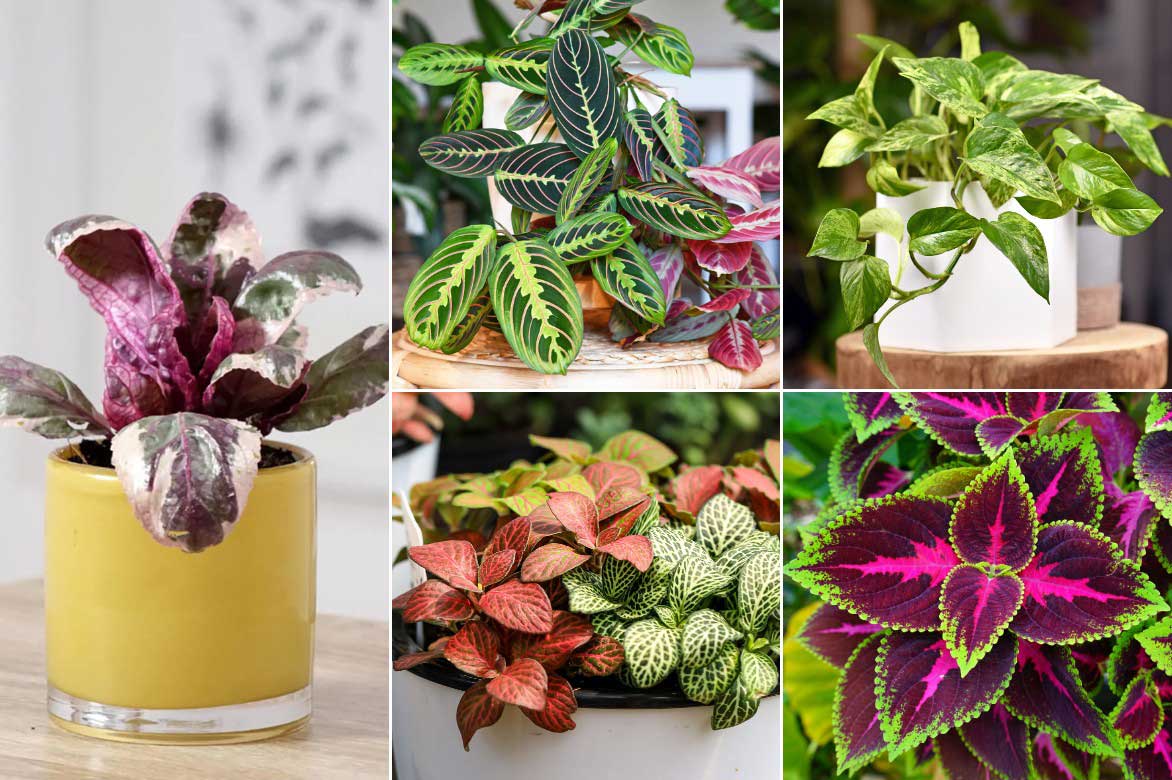
Hemigraphis ‘Snow White’, Maranta leuconeura ‘Fascinator’, Epipremnum aureum ‘Marble Queen’, Fittonia, and Coleus
- Subscribe!
- Contents
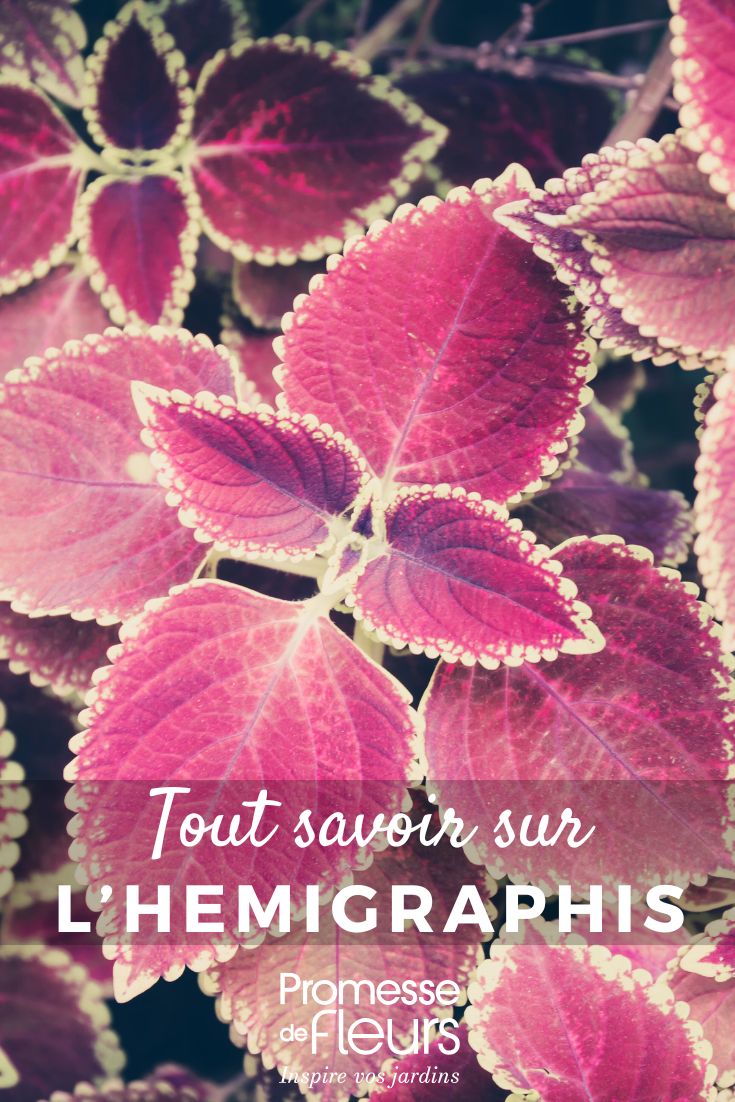































Comments